England play South Africa in the final of the Rugby World Cup today. Tim Dee, unlikely sports reporter, has been living in Cape Town since the middle of June and has sent some notes from his new home. Pictures by Claire Spottiswoode, David Lloyd-Jones and TD.
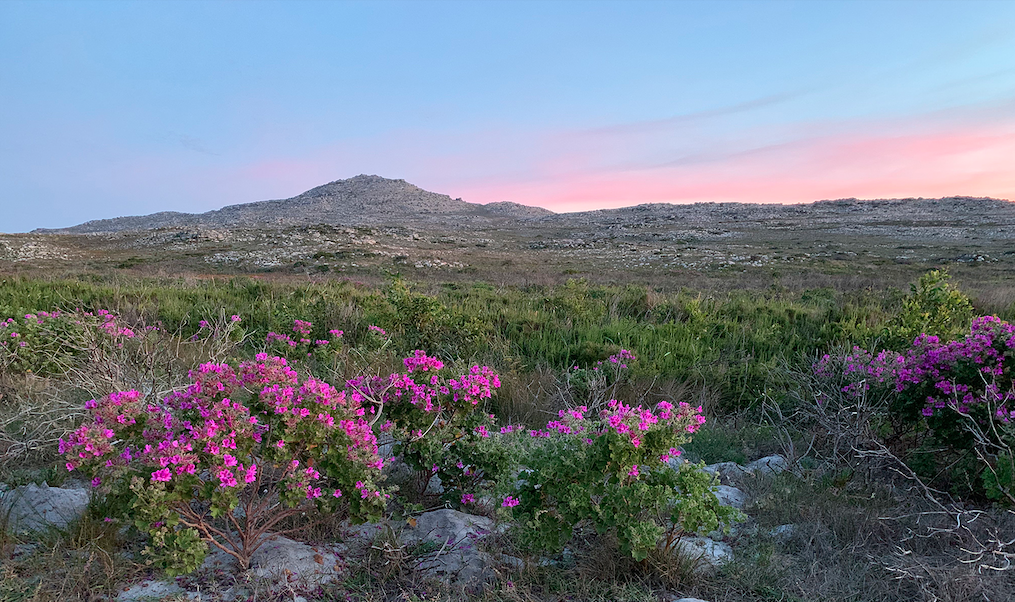
We live on Eland Street; we might have lived on Seagull or Pincushion. There is one house to the south of us and then up rises the first rocky hillside of the Cape of Good Hope section of Table Mountain National Park. Between our seaside village and the park, there is a high fence. But just beyond it, from our south-facing windows, we often see eland. A herd, usually nine or ten animals, moving as one through the drying fynbos and across the pale rocks like a Bushman petroglyph. They are chunky beasts. They have no predators in the park and, since August, this spring, I have seen them with calves too, soft-brown, velvety, toy-like, skittering over the jumbled terrain, at the heels of their more solid and sure-footed parents.
Where we are, no one but our neighbour lives further south. Strictly speaking we are resident in the southern suburbs of Cape Town, but ours is the last but one house before Antarctica. Or so I say: Cape Agulhas, further east, and a sizeable run of the coastline between the two capes, is actually further south and nearer the ice, but the fence, and then the spartan spread of the narrowing peninsula, with the sea frothing all around, the low, distinctive vegetation and the pale bone-show of exposed rocks, the rusting ship wrecks in the Atlantic surf and the bleached whale skulls on the beaches, and, the Cape of Good Hope itself, at the very south-western tip of Africa, that world-rounding, historied place, all conspire to give a finisterre feel to where we are.
Most of the time there are no eland visible from our house, and all of this end-of-the-world land to our south can seem (or has to me, at least) like a draft of a place, or an excavation, a before or an after. Some days it feels that there isn’t anything, let alone anyone, living beyond us, but I try not to think that: I find myself at the bottom of the world, not certain how I might fit in, but knowing that I want to make a home here.
Pincushion Street is named for the yellow or orange flower bursts on one genus of protea bushes: proteas are part of the fynbos flora, with heathers and restios and pelargoniums and seasonal orchids and bulbs with delicate one-day-only blooms. We live in the midst of a floral kingdom unique to the Cape. There are six such on Earth; this one in the tiny tip of southern Africa is much the smallest. All the garden geraniums in the world originate from the wild pelargoniums round me now. As the spring has advanced, I have been running beneath hillsides beautifully bruised with their purple flowers. The yellow and orange pincushion bushes are brighter still, each like an orrery of the sun in all of its moods. Arum lilies grow freely too, waxy white, tall and funereal, and flaming Ericas (red and yellow, some pinks and whites – heather is more diverse in fynbos than anywhere else on Earth, with more than 600 species), and electric green Leucadendrons, which seem to switch on an extra viridian brightness on damp and overcast days.
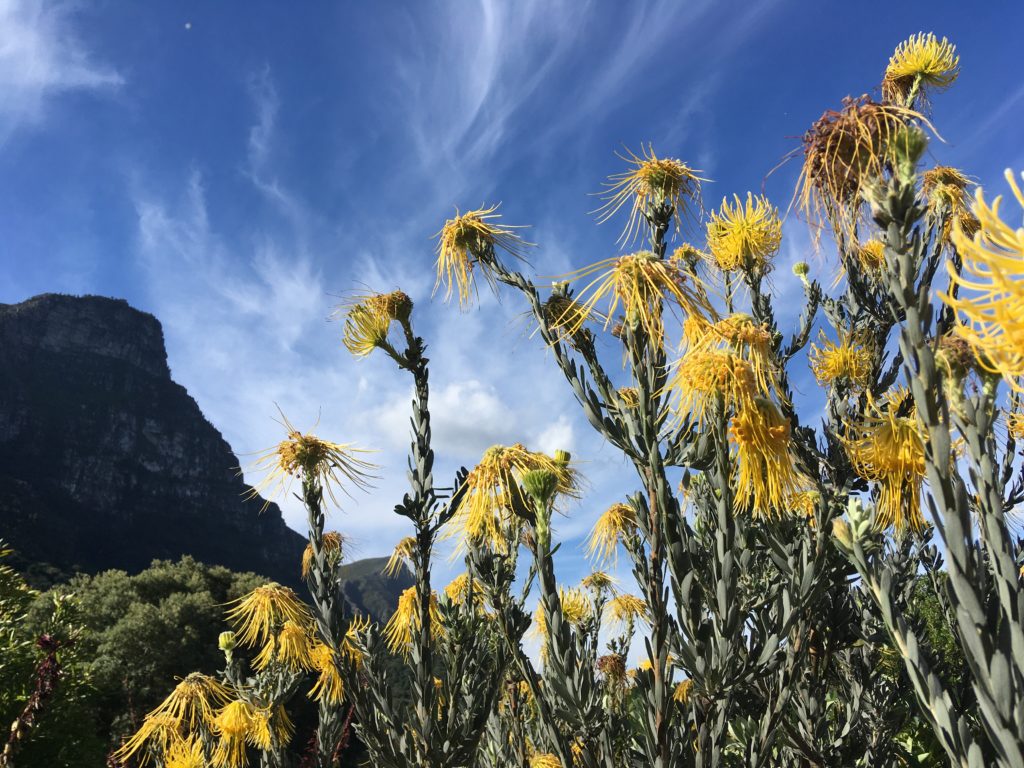
The soil is poor on the peninsula; European-type farming never really worked here, and now the last southern kilometres of the Cape are protected. We have a Wild Card that allows free access to the park: we walk there (run sometimes), botanise (there are few land birds), count tortoises and hartebeests and zebras and bontebok, and if the wind isn’t too furious, return north along the Atlantic shore birdwatching (clawless otter watching occasionally, when a pair have snaked out of the sea and lolloped up the sand to their holt), and checking on how the whale bones and the shipwrecks progress in their slow, sea-washed, telling of the ends of things. I have picked up a sea-bean here, an oceanic-drifter, and we’ve watched shy albatrosses and white-chinned petrels gunning offshore in devilish weather. We must be out of the park by sunset. No day visitor may see the end of the day there; no one may see the end of the world from the end of the world.
There are no native trees here; nothing grows taller than an eland. Fire drives the fynbos ecology, burns are necessary; and between the park fence and our houses there is a firebreak of cleared ground. Periodic fire is needed for the vegetation to flourish – a burn triggers extraordinary and beautiful new growth. We are keen to plant only local native species in our small garden, but we don’t want the fires to jump the fence (one did last year) or for our house to burn down (some have). Many villagers are enrolled as fire wardens. I must sign up soon as well. Some village gardens have eucalyptus trees and pines and other highly flammable aliens, but even the native species get bushy and overgrown in the absence of fire. Villagers around us employ Malawians and Zimbabweans – migrant labourers, who live up the road from us in Redhill – to clear excess veg and do the work of the flames.
There aren’t many overcast days. Blue is the norm. A galloping marine-made blue. The air effervesces too: it fizzes off the ocean, most detectably when shipped in either from the north-west or the south-east, the two cardinal points that rule our weather. The air from there seems truly fresh. Surely no one has breathed it, not even a whale, before us: it makes every day feel incoming and uncreated, as D.H. Lawrence said they were, in the early springtime, along the north Cornwall coast in 1916.
Looking out from our living room I can see the sun set into the ocean every evening. When I got here in midwinter in June it was cracking its yolk into the Atlantic at about six o’clock, now it is after seven. I look west when I can and always hope for a green flash. I’ve seen nothing yet; but the fireships flaming down and the rifts of ore opening at the skyline are quite enough. Could someone write a book, I wonder, that was just words on every sunset in one place for one year? I look at the ocean most days and ask the same of the sea: you could say almost anything about it and it all would be more or less unsatisfactory, but shouldn’t you try?
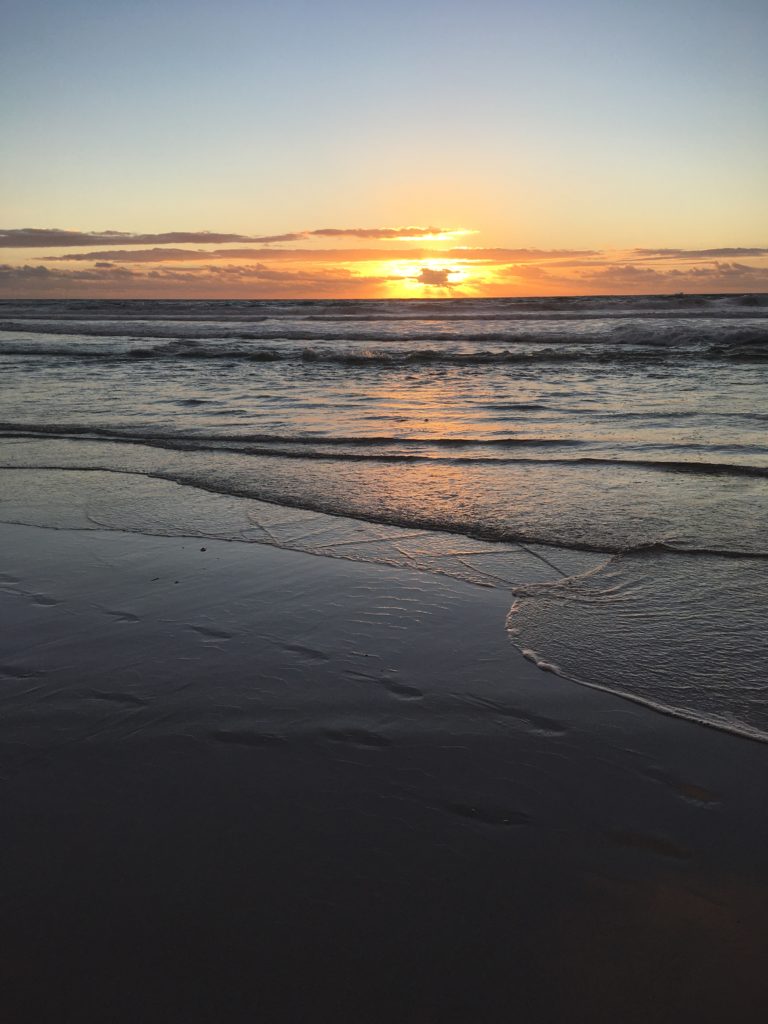
I say that, probably, because one half of my intention in coming here and living more continuously with Claire, my wife (she is from Cape Town and works here), was to have a place to finish a book, many years in the making, of nature writing. There, I have said it; that is what I have written about, specifically about the nature of spring, though the genre term has come to seem problematic, even toxic when the text is made by someone like me, a privileged tourist, burning up the planet and writing up his adventures. (Carpe diem? Mea culpa!) Anyway, I have done what I have done and we will see how it goes. My worries, in fact, are less to do with what I have written about and more to do with how I have put it all into words. I have struggled to find language commensurate to or good enough for the ocean or for the Sahara or for the Arctic. And probably for all the birds I have watched in between as well. How to get that right? To put what you see together with how you see it; to capture something of the way, as Gerard Manley Hopkins described it, that the harder you look at something, the harder it looks back at you? The book attempts to follow the spring through Europe, mostly in the company of migrant birds from Africa; but it begins with the view from our living room out over the Atlantic where every last few years I have seen barn swallows, our swallows as I still cannot help calling them, away from their home, as I still cannot help thinking it, in the South African midsummer, which is the European midwinter.
I came here having delivered a first draft of the book – it will be called Greenery and will be out in Britain next March, in time for the swallows’ return from my new home to my old haunts. I left Britain this year at midsummer, around the summer solstice and I arrived therefore – this topsy-turvy converse-season thing also being one of my creative kick-starts – around the South African midwinter. Spring was ending when I stepped on the plane and was beginning as I stepped off. This year I will have had two of what is surely the best season. And, in them, I have revised and finished my writing and delivered my text. I also came to Cape Town to await another delivery. Claire was expecting a baby – our first – in August. Two springs, then, for me this year, two springs and no autumns, nor much of a summer or a winter. Or three even: a man in fall (I feel about 800 years old) being given the spring of a new life?
There are seagulls too here in Scarborough, as the road name implies. Only two species: kelp (large and black-backed) and Hartlaub’s (like a redesigned black-headed gull). A year or so ago, I wrote much of Landfill, a book about gulls, here, and followed the birds across the peninsula from us to the Cape Town city dump, just inland from the epic beach (many surfers and sometimes shark-attacks) at False Bay. There, they live as urban gulls: that was my principal subject. But, the truth is, in fact, that the gulls of South Africa are still by and large seagulls, real ones. They are dead whale eaters; they are the flying partners of prions and petrels; they clear off when you come too close.
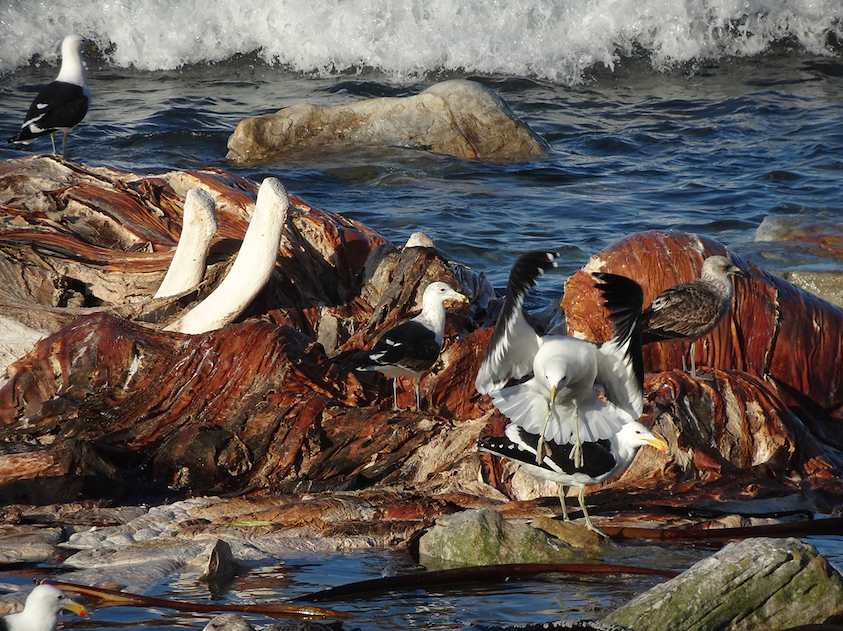
There are, though, gull-types that are not gulls in Scarborough. If I wanted to write another instalment of Landfill, I could write about the compromised uglies that are around me now: the sacred ibis that has trashed its name by living most happily on human rubbish, soiling its angel-white plumage as it grovels in the shit; the hadeda ibis (named for its brash nasal calls) that has spread virulently in urban places in South Africa and is seen by many as a panhandling immigrant (back in the city, they keep our friend, Mark, awake, as they loudly fail to roost at night in a tree outside his bedroom; ‘Their beaks’ he says ’are not even properly evolved.’); and the Egyptian goose that has made its home out of being apparently homeless everywhere, and which, even otherwise enlightened, birders here call Gypos.
I said there were no people, just geese and ibises and eland and whales living south of us. That is not the best way to put it. Strandloper communities made a living from the Atlantic shore for thousands of years. Shellfish has been good for accelerating the development of the human brain. We too compete with the black oystercatchers (all black but for crab-red feet and beaks) for mussels on mussel-beach at Scarborough. And there were people – not strandlopers – living in a similar latitude to us more recently too. Some of the families who now live in Ocean View were forcibly removed from places on the Cape Peninsula declared to be ‘white’ under the Group Areas Act of the Apartheid era. Ocean View is a ‘coloured’ village. The name of the place is ironic at present. Its inhabitants could see the sea where they once lived, but cannot where they must live now. White people claimed their sea view and have held onto it. Ours always was (and mostly remains) a white village. Economics today, rather than racist legislation, keep most of the South Africa that I have seen, colour-coded. No matter how all meet and mingle during the daytime, in schools, workplaces, hospitals, shops, much of South Africa still sleeps alongside people of the same skin colour. Redhill, our neighbouring village, is largely black. Ocean View is not far from either of us. I have had to get used to the word coloured, too. It still applies and is used by those it applies to. There is a lot to learn, most of it cannot be got out of field guides, and not all of it is, by any means, good news.
There are African penguins breeding on the False Bay side of the peninsula: they have been given fibreglass half-barrels to nest in at Boulders beach. They were once called jackass penguins (they bray), but their name has been tidied up in a way that feels like a politically correct revision. An African penguin sounds like an oxymoron; a white South African might feel the same about themselves. Present day Cape Town is a good place to challenge and expel many received ideas. Living here prompts questions (good and bad) all the time about who and how anyone might live here.
Tourists on daytrips to the Cape of Good Hope can expect penguin-stops at Boulders and later, in the national park, ostrich-stops. It’s a good place for the flightless. But, in fact, the ostriches have been reintroduced, and the Cape is actually not close to penguin-central or to the ice of Antarctica. One thing I have learned, contemplating those waddling penguins and caravanning ostriches, and looking at those swallows from Europe flying around me at the bottom of their world (all three birds augur as all birds might), is that South Africa is not actually so south. Its southerliness comes from the fact that there is nothing between it and the ice except for sea. That is for me an absolutely determining and terrible thought – terribly determining. If you flipped Africa on a globe, bottom to top, Cape Town would turn out to be about as far north in the northern hemisphere as Casablanca. The other way up, all of Europe would be sea. South of me, therefore, the sea, between the penguins, the ostriches, and the swallows and the ice of the Antarctic, is the equivalent of the whole of the landmass of Europe. It is no wonder that a species of wild surmise – the sort Keats described Cortez and his party sharing, on a peak in Darien – overcomes you when you look out at that sea, its incomprehensible fetch as wide as the land is from Gibraltar to the Nordkapp. It is so big it can only be terrifying to know, even at its calmest moments. Indeed, sometime the calm is more deadly than the storm: it is when your murderer smiles at you that you really know that your time is up.
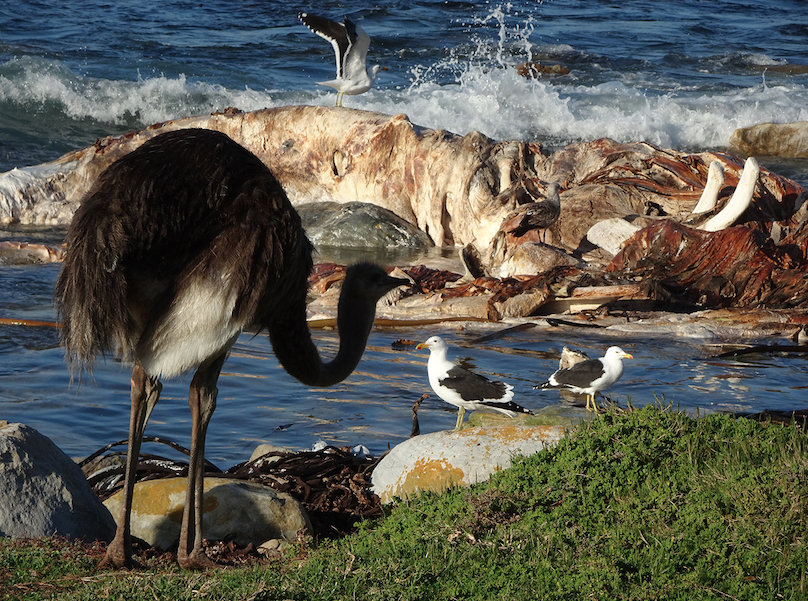
Regarding penguin I have no evidence, but ostrich is delicious as a sausage or burger or kebab. Eland sometimes are the game-cut of the day at a restaurant back towards the city where we occasionally eat. Ostrich is always on, kudu, zebra, gemsbok sometimes. There are cheaper meats. Russians, which are lurid frankfurters, are often for sale in corner-shop superettes. Walkie-talkies are grilled or deep-fried chickens’ heads and feet. I have fallen more for milk tarts and koeksisters. The sea is edible too. As well as Scarborough mussels, local trawled hake is great and, I hope, sustainable; I’ve also eaten yellowtail and kingklip (ugly like a cusk-eel, but tasty), and I really like smoked snoek though it sounds like an accident waiting to happen. Ironically, sanctions and the economic blockade of South Africa during the Apartheid era resulted in the country making big efforts to produce much of its own food. I’ve never had a shopping basket as home-grown. The avocados are perfect. It is easy to live without imports. There is even locally made Marmite.
When I have the energy, I run to keep the milk tarts at bay, north out of our village and along the road at the ocean to Misty Cliffs and then back. Offshore, through June and July, whales, humpbacks, blew and breached. I felt them somehow clocking my paltry exertions. This year a humpback clan or something like that has taken up residence in False Bay and others following their round-cape migrations have been more obvious than before. Numbers are thought to be good. Killer whales have been seen in False Bay too (not by me) and the great white sharks there have disappeared (I mentioned an encounter with one once for CBTR). The two facts are probably related. The shark spotters at Muizenberg, who used to raise flags and sound alarms to warn swimmers and surfers, now track cetaceans. On my runs, on our side of the peninsula, looking west out to sea, I have learned the difference between a white water wave splash and the demolition smack of a breaching humpback, and have felt marvellously ventilated every time I caught the towering sparkle of a misting blow. Somehow that mammalian exhalation through those last molecules of water, as the whales surfaced, was evidence of a working of the world, a working at the world, which gave me life: catching their breath, I caught my own.
Southern right whales bring their young to the Cape’s waters. Their reproductive cycles – long gestations – mean more come some years than at other times. This year has been an in-between sort of year, but we have seen a few. In Scarborough, they appear just off the beach, at the sea-surface like drifting barnacled logs. Once, between close-in right whales and far-out humpbacks, a large pod of common dolphins, two hundred perhaps, made a kind of whipped up bath of the sea as they crossed the bay in ecstatic hunt.
On one run, towards dusk on a July day, the ocean was browned out: a spotted eagle owl that works the rocky slopes of the hill between Scarborough and Misty Cliffs was perched on a roadside bush as I panted past. It looked like an ancient rug hung out to dry. I almost missed it, in my sweating effort, and it only noticed me when I pulled up quick at just an arm’s length from it. It too had been scanning the waves. We both, I’m sure, looked equally surprised. No bird more than an owl puts us, I think, so much in mind of meeting a person. It hissed once at me, as if I was an enemy, then dropped silently – muffling or muting every particle of air around it – down the cliff towards the beach. I wooed after it and ran on. Owls have friends in the village: a Good Samaritan picked up from a road a sickly spotted eagle owl one night not long ago. They fed it on porridge and hung a healing crystal, like an Olympic medal, around its neck. Come daybreak, they were distraught to find it face down and dead.
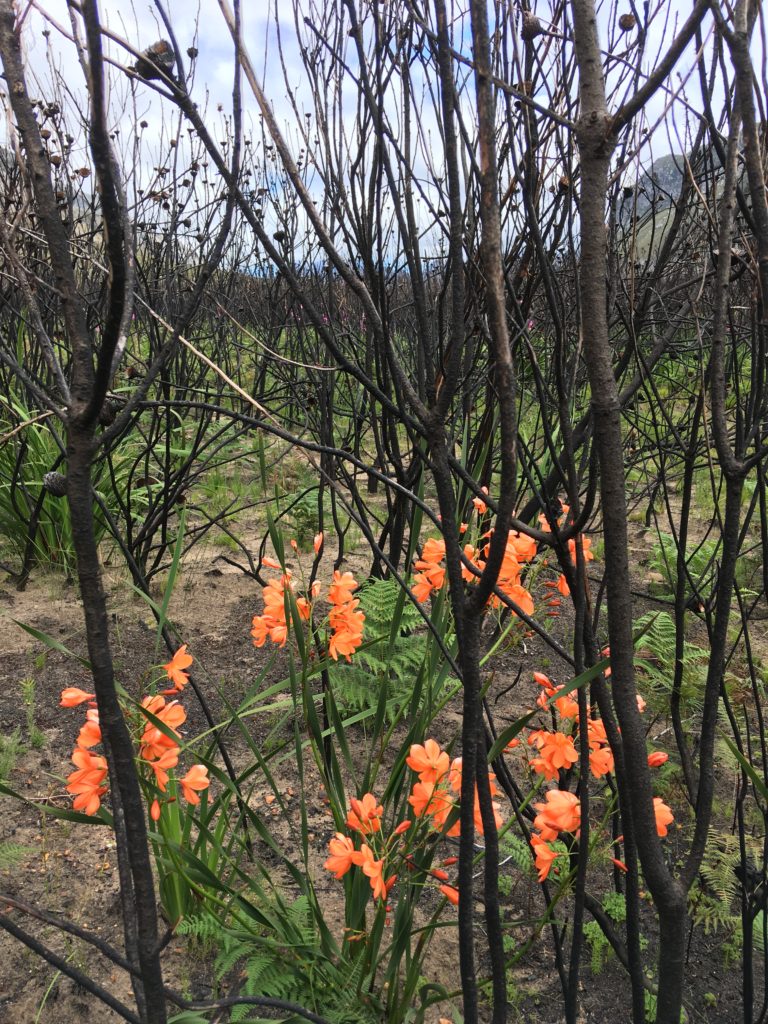
Baboons would make an even better modern nature story than those dirty ibises and itinerant geese. Our first neighbours beyond our village are monkeys. A troop (or the remnants of one) lives alongside us, on the rocky hill behind, but also in our gardens and, when they can, in our houses. We are generally good to be tapped. At the moment, the baboons divide opinion. A meeting this very week has been called to try to thrash out a consensus. It won’t be the first such attempt. Mongrel or feral life, the remnant wild forced into all kinds of inbetween existence, is a classic marker of the anthropocene. And it is here for sure on this particular stretch of the planet of the apes. Dogs bite people on the beach far more than dogs are bitten by baboons; a wild caracal has been reported eating the cats (all but their heads) that live on Hilltop Road. Scarborough has crystal-healers and barefoot shamen, but it also has snake-wranglers who will clear a cobra from your braai wood stack. It has dog-lovers and cat-lovers and people who call up noise-nuisance regulations and log the illegal barks of their neighbours’ pets. It has home-brewers and sourdough bakers. It has web designers and doctors. It has conservation ecologists and alien vegetation experts. All of us carry something of the baboons with us, some version of them, some account. Every one of Cape Town’s four million people may well have a baboon incident to retell.
At Constantia, in the shadow of Table Mountain, there is an outdoor restaurant beautifully located under an avenue of ancient – they were once imported acorns – European oaks. The trees – to my eyes, gorgeously salad-green this spring, like nothing native – also host breeding European chaffinches. They came to Cape Town thanks to Cecil Rhodes. Out of some misguided sense of deficit in the native bird population, Europeans shipped birds from their old countries to their new colonies; the same happened with the starlings of North America (they are in Cape Town too, Claire grew up calling them eurostars), and the blackbirds and yellowhammers of New Zealand. Our baby’s first outing – Hello to Adam, born 14 August – was to this restaurant. Before our lunch arrived an attack took place. The restaurant is part of a wine estate and ringed with a supposedly baboon-proof electric fence. On all fours, but like a regular diner walking to his preferred table, one appeared at our side. It was heavyset, with a beat-up boxer’s face, and dressed in overcoat grey; it travelled nonchalantly, but decisively, and picked up speed at it passed us. With an extraordinarily deft swipe, it raised its right hand to table-height and collected a burger (meat species unknown) from the plate of a man sitting next to us. Its arm curled its prize into its orange-toothed maw and it was eating already before the first shout came from its victim. By the time a waiter appeared and beat the ground with a spade as he advanced on the animal, the credits were rolling, and the burger long gone.
Baboon solutions are among the pest controls offered by various companies across the city (I saw one truck labelled The Verminator), but no one has yet sorted them for sure. Some like the word euthanase, others are certain no such fixing is required. Some see them as victims, some as aggressors. There are street signs that advise that baboons are dangerous wild animals. They mustn’t be fed and you should lock your car against them. They feed themselves well enough in our places. Our rubbish bins have baboon-proof catches; but not all kitchen windows are kept securely locked. The fence between our village and the national park prevents eland and zebras from straying, but not the Scarborough Four.
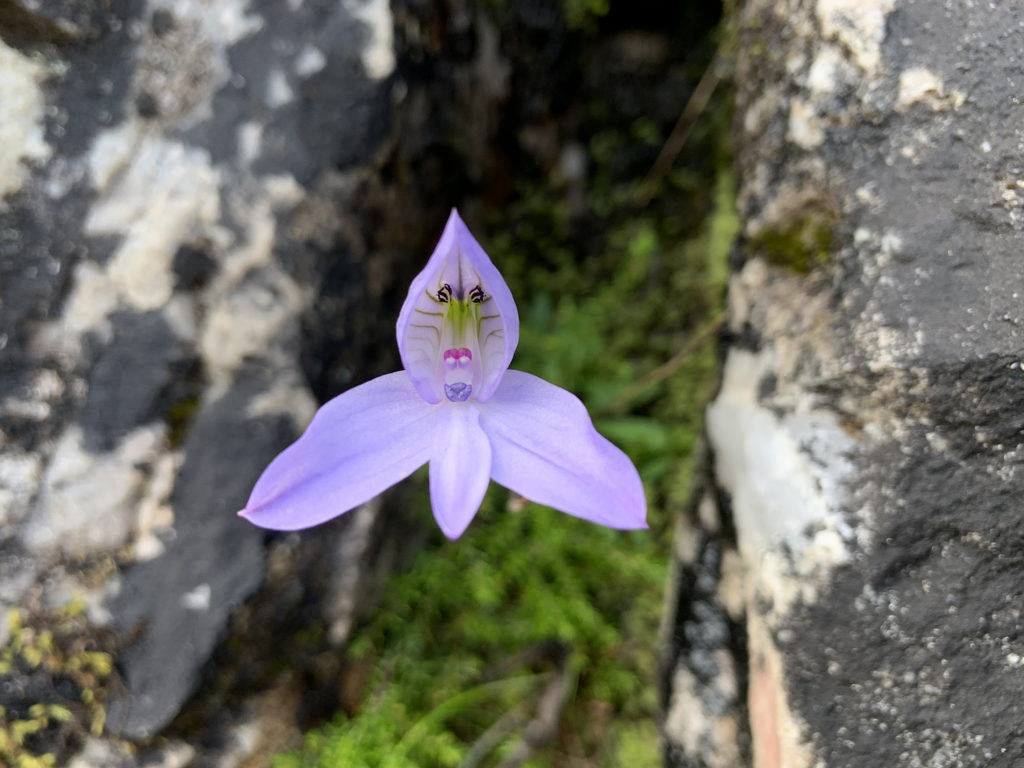
In our village, we pay a private security business to attend to our burglar alarm. Some houses are fortified with purpose-built electric fences – Shock-O-Loza is the name of one company. Alongside such defences, a private outfit paid for by the City polices the baboons. But it is expensive. Virtual fences, if they can be erected, are regarded by pest-experts as more efficacious than wire ones. All day long, in all conditions, trained guards walk wherever the baboons go. They are armed with paint guns that are supposed to be understood as a barrier. Mind games are preferred to all-out war. The guards function as a rival troop. Sometimes, this hasn’t been enough and colourful shots (bright green mostly) have been fired. Sometimes, still, the baboons trespass. In July, I watched a female take a slow shit on the roof outside my writing room and then retrieve a papaya skin a neighbour (not me!) had inadequately binned. Like the king of the castle, she brought it back to the roof and stripped the skin of its sweet scraps of yellow fruit. Two guards gathered at ground level and fingered their weapons, but she took her time. It might not end well for her. Those animals that will not learn have been dispatched with something stronger than a paint pellet. Euphemisms abound. And protests have followed. Hence our divided village, hence the crisis meeting, hence the sign hung from a café, Save the Scarborough Four, hence the waiters in the café knowing where the spade is stored.
It rains in the winter in Cape Town (a drought last year is likely to come again, but this winter has been wet and went some way to fill the reservoirs). It never freezes but it is cold enough. Very few people have central heating. I put on a down-jacket indoors. Many residents live in shacks, home-made, and are adept at keeping them dry; they might have a stove. Shopping carts from supermarkets are often borrowed as wheelbarrows for wood that is collected from odd commons and corners and patches of vegetation about the city. I saw a man carrying a wooden pallet on his head up the central reservation of a city motorway. We are lucky and can afford to have wood delivered. When we call Rosario, he sends two guys around with a little pickup truck stacked with chopped logs. The last load was olienhout, wild olive, wonderfully aromatic, heavy and slow burning. It will be next winter’s heat. We ask for alien wood when possible. In his house, back in the city, my father-in-law burns thick logs of oak that he salvages from alien cutting dumps. We are all aliens here of course, but many are exercised by the wrong sorts of trees that, thanks to us, crowd around. There are proper (good, ecological) reasons to be concerned by the impact aliens have on the native scene, but perhaps the zeal to amend – to ungarden what their ancestors planted – is also a displaced kind of expiation for some of the guilt of an apparently alien human. The baboons, the chaffinches, the oaks, the people always from elsewhere, you can see it all as part of the same unfinished – perhaps unfinishable – business. Our friend Mark (he of the hadeda-hate) is a wholly good man and fully gets all this, and on mountain walks carries in his rucksack a folding saw to deal with any pine tree he comes across. After the baboon burger raid, the second most violent incident I have seen here was Mark hurrying from a mountain path to yank a wattle-tree from the ground and toss it away, cleaning up the fynbos. In such ways, as best we can, we make our corrections.
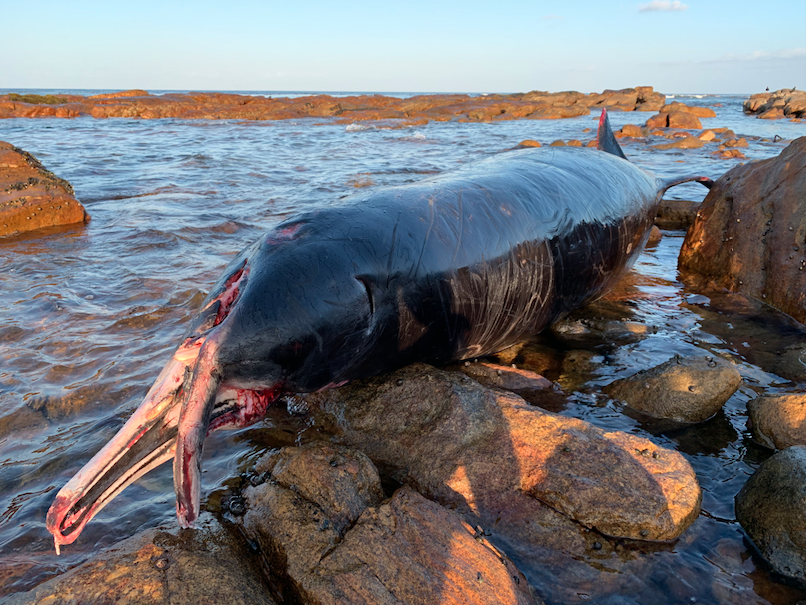
At Buffalsbaai, on the False Bay side of the Cape Peninsula, some sea currents apparently conspire to drive marine life ashore. Stuff regularly washes up. Through the winter, we went there most weeks to check on the decay of a humpback whale corpse, first with our baby swimming still within his mother, later with him strapped in a sling. The blubber deliquesced in the rocky shallows; the animal’s rib bones appeared like slivers of a drowned moon. A month after, there was a new tick for all of us, when we hurried to the same beach to see a dead Gray’s beaked whale – a deep-diving pelagic mystery mammal, looking like a broken-nosed black torpedo – that had bobbed ashore freshly dead at the same place. And just this week, various WhatsApp groups jiggled and buzzed when a king penguin, a very rare vagrant to South Africa from Antarctica, walked out of the same surf having swum thousands of miles from where it should be. It is still alive as I write (all the birders have cleaned up), and is being looked after, in its new home of the car park at the beach, by park guards who move a cordon of traffic cones around it when it chooses to waddle. If only it would tell us what it thinks has happened?
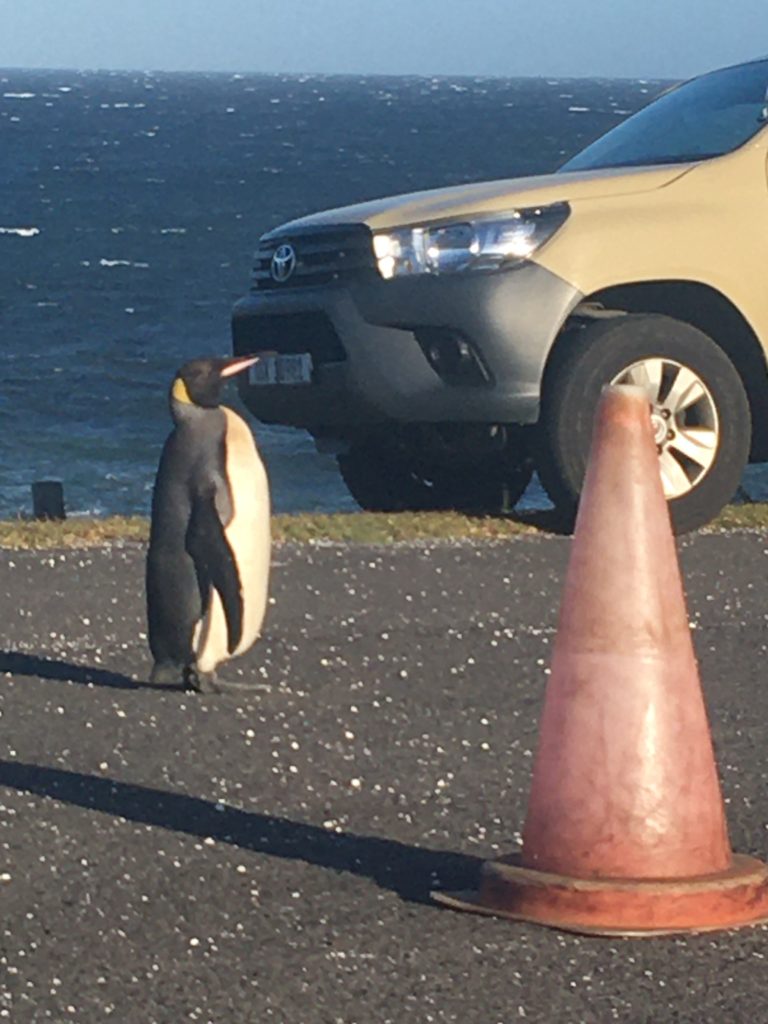
Driving back home from the penguin twitch we saw the first returning barn swallow of the southern spring, flashing above the fynbos, like it had never been away.
And the rugby? The Springboks are playing the English today. I’ll be watching the final on TV at the home of our friends, Jay and Guy. Jay says she might have to sit in another room and call her husband by phone for updates if it gets sticky. Here in Cape Town no one expects me to do anything other than cheer for my old country, but I am not so sure. I like the look of the Beast, as they call one player. And I remember, with muddied horror, being shouted at to dive at the legs of a fast-running heavy English oak tree on a bleak Saturday afternoon in South London in the early 1970s. The only thing that makes Claire cry is seeing South Africans being nice to one another. I find these days that I cry when she does.
*
Tim Dee’s new book Greenery will be out from Jonathan Cape in March 2020. Little Toller published his last, Landfill, in 2018.